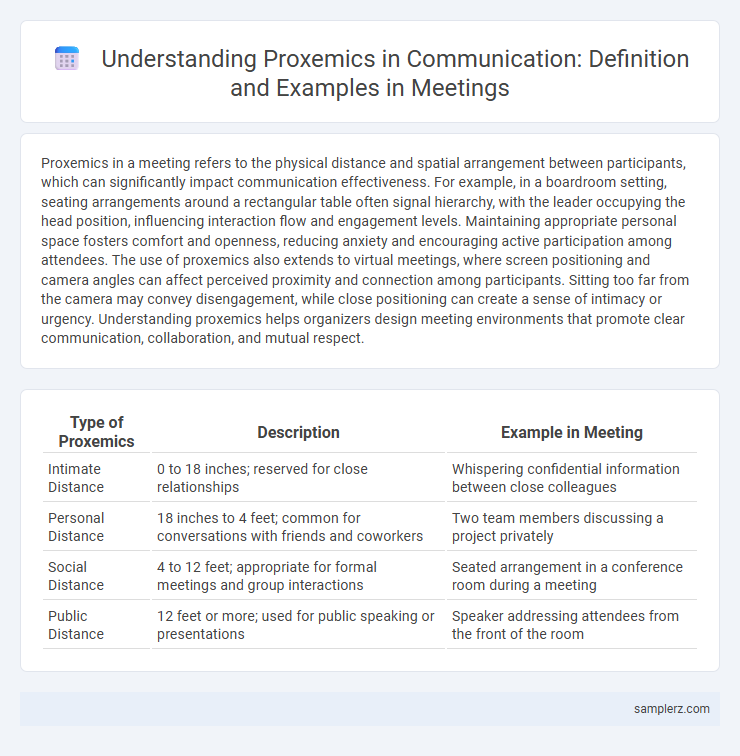Proxemics in a meeting refers to the physical distance and spatial arrangement between participants, which can significantly impact communication effectiveness. For example, in a boardroom setting, seating arrangements around a rectangular table often signal hierarchy, with the leader occupying the head position, influencing interaction flow and engagement levels. Maintaining appropriate personal space fosters comfort and openness, reducing anxiety and encouraging active participation among attendees. The use of proxemics also extends to virtual meetings, where screen positioning and camera angles can affect perceived proximity and connection among participants. Sitting too far from the camera may convey disengagement, while close positioning can create a sense of intimacy or urgency. Understanding proxemics helps organizers design meeting environments that promote clear communication, collaboration, and mutual respect.
Table of Comparison
| Type of Proxemics | Description | Example in Meeting |
|---|---|---|
| Intimate Distance | 0 to 18 inches; reserved for close relationships | Whispering confidential information between close colleagues |
| Personal Distance | 18 inches to 4 feet; common for conversations with friends and coworkers | Two team members discussing a project privately |
| Social Distance | 4 to 12 feet; appropriate for formal meetings and group interactions | Seated arrangement in a conference room during a meeting |
| Public Distance | 12 feet or more; used for public speaking or presentations | Speaker addressing attendees from the front of the room |
Understanding Proxemics: The Role of Space in Meetings
Proxemics plays a crucial role in meetings by influencing communication dynamics and participant comfort levels through spatial arrangements. For example, seating positions in a conference room--such as closer proximity during collaborative discussions or increased distance in formal settings--significantly impact nonverbal cues and engagement. Understanding these spatial relationships helps optimize meeting outcomes by fostering effective interaction and minimizing misunderstandings.
Types of Proxemics Zones in Professional Settings
In professional settings, proxemics zones in meetings typically include intimate (0-18 inches) for confidential discussions, personal (18 inches to 4 feet) for close collaboration, social (4 to 12 feet) for group interactions, and public (12 feet or more) for formal presentations. Understanding these zones helps optimize spatial arrangements for effective communication and comfort. Adjusting seating based on proxemics zones can reduce misunderstandings and promote positive engagement among colleagues.
The Impact of Seating Arrangements on Communication
Seating arrangements in meetings significantly influence communication dynamics by shaping participants' comfort levels, eye contact, and perceived hierarchy. Circular seating fosters open dialogue and equal participation, while linear or U-shaped setups may emphasize leadership and control, impacting message flow and collaboration. Understanding proxemics allows meeting organizers to strategically arrange seats to enhance engagement, reduce misunderstandings, and promote effective information exchange.
Personal Space Preferences During Business Meetings
Personal space preferences during business meetings vary significantly based on cultural background and individual comfort levels, influencing effective communication and rapport. Maintaining an optimal distance, typically ranging from 1.5 to 4 feet, fosters a balance between professionalism and personal comfort, reducing anxiety and enhancing mutual respect. Awareness of proxemics, such as seat spacing and body orientation, plays a crucial role in minimizing misunderstandings and promoting productive interactions in corporate environments.
Cultural Variations in Proxemics within Meetings
Cultural variations in proxemics significantly influence meeting dynamics, with different cultures maintaining distinct interpersonal distances that impact communication comfort and effectiveness. For example, Latin American participants often prefer closer proximity, fostering warmth and collaboration, whereas Northern European attendees typically maintain greater distances to respect personal space and professionalism. Understanding these cultural preferences helps facilitate smoother interactions, reduce misunderstandings, and enhance cross-cultural communication in international meetings.
Proxemics and Nonverbal Cues: Enhancing Team Interaction
Proxemics in meetings influences how team members perceive comfort and engagement, with closer physical distances fostering collaboration and trust. Nonverbal cues such as body orientation, eye contact, and spatial arrangement enhance communication clarity and reinforce group cohesion. Optimizing proxemic behavior reduces misunderstandings and promotes effective interaction in team environments.
How Room Layout Influences Meeting Dynamics
In meeting settings, proxemics plays a crucial role as room layout directly influences communication flow and participant interaction. A circular seating arrangement fosters equal participation and open dialogue, while a rectangular setup often creates hierarchical spaces that can inhibit collaboration. Understanding these spatial dynamics helps optimize meeting effectiveness by aligning room design with communication goals.
Managing Distance to Build Trust in Meetings
Maintaining an appropriate physical distance during meetings enhances trust and facilitates open communication among participants. Positioning oneself within a comfortable personal space zone, typically 1.5 to 4 feet, encourages engagement and reduces discomfort. Effective management of proxemics signals respect and attentiveness, fostering stronger interpersonal connections in professional settings.
Proxemics Challenges in Virtual vs. In-Person Meetings
Proxemics challenges in virtual meetings arise from the absence of physical spatial cues, making it difficult to interpret personal space and nonverbal feedback, which are naturally conveyed in in-person settings. In traditional face-to-face meetings, proxemics facilitates engagement through seating arrangements and body orientation that signal hierarchy and collaboration. The lack of these spatial dynamics in virtual environments can lead to misunderstandings, reduced emotional connection, and decreased communication effectiveness.
Practical Tips for Using Proxemics to Improve Group Collaboration
Positioning team members in a meeting according to proxemics principles--such as maintaining appropriate personal space and arranging seats to encourage open body language--enhances group interaction and comfort. Using circular seating arrangements fosters equal participation by minimizing hierarchical barriers, while respecting cultural differences in personal space distances reduces discomfort and miscommunication. Implementing these proxemic strategies improves nonverbal cues recognition and strengthens overall collaboration effectiveness in diverse teams.

example of proxemics in meeting Infographic
 samplerz.com
samplerz.com